a) Exercise 1: What is the Gross Profit per Unit (dollars not %) for the XM1 drive using the Traditional Costing system? See circle on the printed exercise Page 1.
b) Exercise 1: What is the Gross Profit Margin % for the XM2 drive using the ABC system? See circle on the printed exercise- Page 4. Express your answer as a % rounded to one place past the decimal (For example: 68.4%)
c) Exercise 2: What is the Total Cost per Unit for Dept M (dollars and cents)? See circle on the printed exercise-Last page.
d) Exercise 2: What is the Total Cost per Unit for Dept N (dollars and cents)? See circle on the printed exercise-Last page.
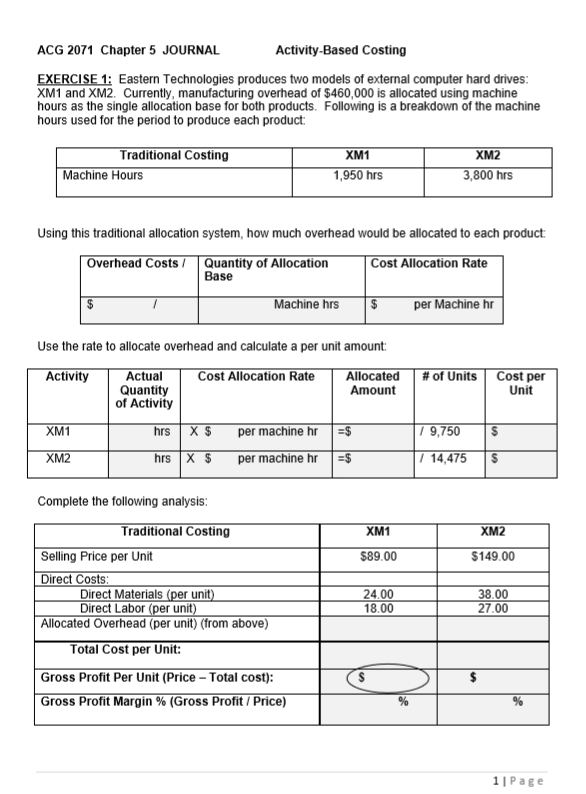
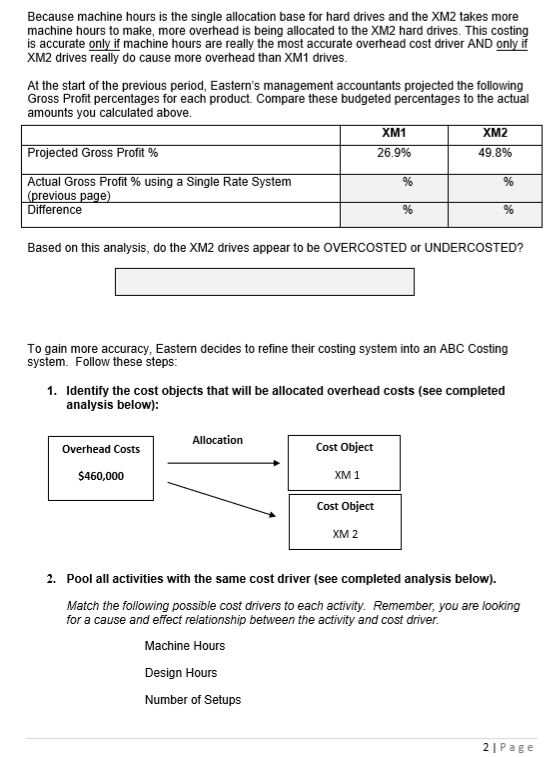

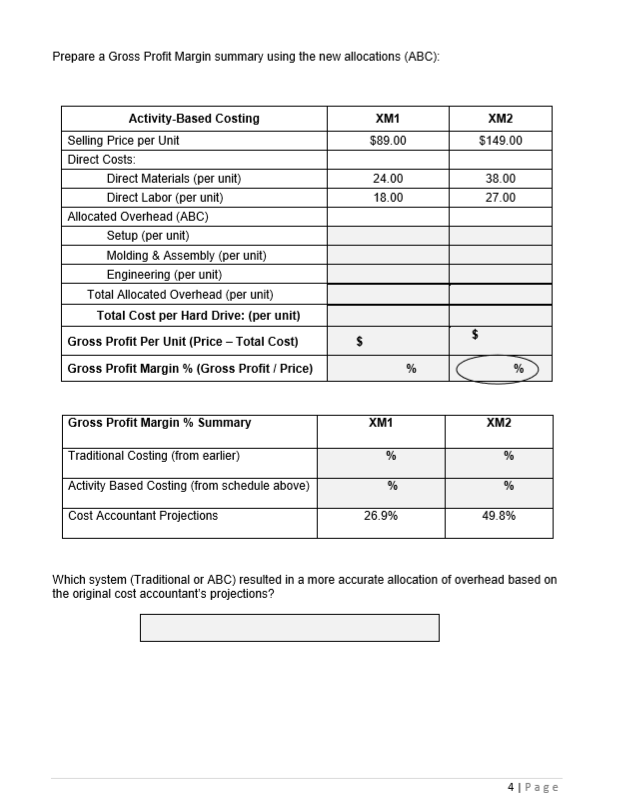

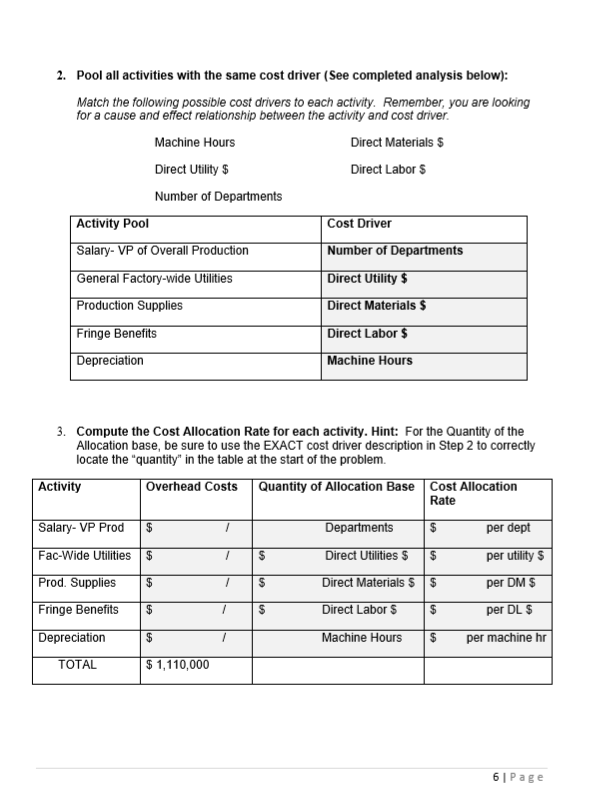
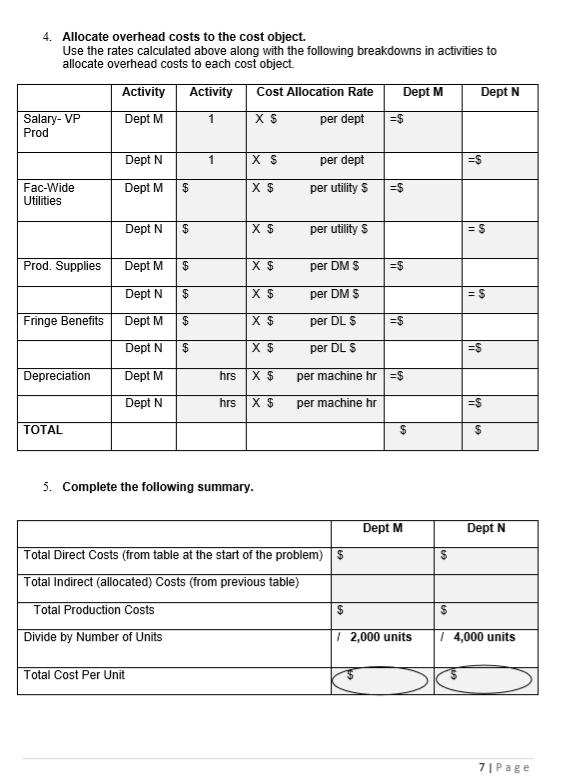
ACG 2071 Chapter 5 JOURNAL Activity-Based Costing EXERCISE 1: Eastern Technologies produces two models of external computer hard drives: XM1 and XM2. Currently, manufacturing overhead of $460,000 is allocated using machine hours as the single allocation base for both products. Following is a breakdown of the machine hours used for the period to produce each product Traditional Costing XM2 XM1 3,800 hrs Machine Hours 1,950 hrs Using this traditional allocation system, how much overhead would be allocated to each product Quantity of Allocation Base Cost Allocation Rate Overhead Costs / Machine hrs per Machine hr $ Use the rate to allocate overhead and calculate a per unit amount Activity Cost Allocation Rate Actual Quantity of Activity Allocated Amount Cost per Unit #of Units 9,750 per machine hr XM1 hrs X $ S per machine hr=$ /14,475 XM2 hrs X S S Complete the following analysis Traditional Costing XM2 XM1 $149.00 Selling Price per Unit $89.00 Direct Costs: Direct Materials (per unit) Direct Labor (per unit) Allocated Overhead (per unit) (from above) 24.00 18.00 38.00 27.00 Total Cost per Unit: Gross Profit Per Unit (Price -Total cost) Gross Profit Margin % (Gross Profit / Price) S % 1| Page Because machine hours is the single allocation base for hard drives and the XM2 takes more machine hours to make, more overhead is being allocated to the XM2 hard drives. This costing is accurate only if machine hours are really the most accurate overhead cost driver AND only if XM2 drives really do cause more overhead than XM1 drives. At the start of the previous period, Eastern's management accountants projected the following Gross Profit percentages for each product. Compare these budgeted percentages to the actual amounts you calculated above XM2 XM1 26.9% 49.8% Projected Gross Profit % Actual Gross Profit % using a Single Rate System (previous page) Difference % % % Based on this analysis, do the XM2 drives appear to be OVERCOSTED or UNDERCOSTED? To gain more accuracy, Easten decides to refine their costing system into an ABC Costing system. Follow these steps: 1. Identify the cost objects that will be allocated overhead costs (see completed analysis below): Allocation Cost Object Overhead Costs $460,000 XM 1 Cost Object XM 2 Pool all activities with the same cost driver (see completed analysis below) 2. Match the following possible cost drivers to each activity. Remember, you are looking for a cause and effect relationship between the activity and cost driver. Machine Hours Design Hours Number of Setups 2| Page Activity Type Activity Pool Cost Driver Number of Setups Batch-Level Setup Machine Hours Molding and Assembly Unit-Level Engineering costs Design Hours Product-Level Compute the Cost Allocation Rate for each activity 3. Activity Overhead Costs Quantity of Allocation Base Cost Allocation Rate $146,250 50 setups per setup Setup Molding and Assembly $208,750 per machine hr 1,670 Machine Hours 1,050 Design Hours Engineering $105,000 per Design hr $460,000 TOTAL Allocate overhead costs to the cost object Use the rates calculated above along with the following breakdowns in activities to allocate overhead costs to each cost object Calculate a Cost per Unit (round to the nearest cents) 4. Activity Activity Cost Allocation Rate # of Units Allocated Per Unit Setup 30 9,750 XM1 X $ per setup $ 14,475 XM2 X $ per setup $ Molding& Assembly per machine hr 858 XM1 X S 9,750 per machine hr 812 XS 14,475 XM2 Engineering 9,750 766 X $ per design hr XM1 per design hr 14,475 XM2 284 X S $ 3 I Page 20 Prepare a Gross Profit Margin summary using the new allocations (ABC) XM1 XM2 Activity-Based Costing Selling Price per Unit Direct Costs: $149.00 $89.00 Direct Materials (per unit) 24.00 38.00 Direct Labor (per unit) 27.00 18.00 Allocated Overhead (ABC) Setup (per unit) Molding & Assembly (per unit) Engineering (per unit) Total Allocated Overhead (per unit) Total Cost per Hard Drive: (per unit) Gross Profit Per Unit (Price - Total Cost) Gross Profit Margin % (Gross Profit/ Price) % % Gross Profit Margin % Summary XM1 XM2 Traditional Costing (from earlier) % % Activity Based Costing (from schedule above) % % Cost Accountant Projections 26,9% 49.8% Which system (Traditional or ABC) resulted in a more accurate allocation of overhead based on the original cost accountant's projections? 4I Page EXERCISE 2: Gerald Manufacturing makes two different Products, M and N. The company's two departments are named after the products. Product M is made in Department M. Product N is made in Department N. Following are the annual costs and other information associated with these two products. Direct costs: Dept M Direct Costs: Dept N Indirect Costs (Overhead) $180,000 Salary- VP of Overall Production Salary- Department Supervisor $76,000 $56,000 $300,000 $420,000 Direct Materials $240,000 $680,000 Direct Labor $120,000 $24,000 Direct Utilities Cost $36,000 General Factory-wide Utilities $36,000 Production Supplies $138,000 Fringe Benefits Depreciation $720,000 $1,110,000 TOTAL OVERHEAD 5,000 hrs 1,000 hrs Machine Hours Gerald Manufacturing uses an ABC Costing system. Follow these steps: 1. Identify the cost objects that will be allocated overhead costs (See completed analysis below): Allocation Cost Object Overhead Costs Dept M $1,110,000 Cost Object Dept N 2. Pool all activities with the same cost driver (See completed analysis below): Match the following possible cost drivers to each activity. Remember, you are looking for a cause and effect relationship between the activity and cost driver Machine Hours Direct Materials $ Direct Labor $ Direct Utility $ Number of Departments Activity Pool Cost Driver Number of Departments Salary- VP of Overall Production Direct Utility$ General Factory-wide Utilities Direct Materials $ Production Supplies Fringe Benefits Direct Labor $ Depreciation Machine Hours 3. Compute the Cost Allocation Rate for each activity. Hint: For the Quantity of the Allocation base, be sure to use the EXACT cost driver description in Step 2 to correctly locate the "quantity" in the table at the start of the problem. Quantity of Allocation Base Cost Allocation Activity Overhead Costs Rate Salary- VP Prod Departments per dept Fac-Wide Utilities per utility $ Direct Utilities $ Prod. Supplies per DM $ Direct Materials $ Fringe Benefits Direct Labor $ per DL $ Depreciation per machine hr Machine Hours $1,110,000 TTAL 6I Page 4. Allocate overhead costs to the cost object. Use the rates calculated above along with the following breakdowns in activities to allocate overhead costs to each cost object Activity Activity Dept M Dept N Cost Allocation Rate Salary- VP Prod Dept M 1 X S per dept Dept N 1 X S per dept Fac-Wide Utilities Dept M $ X $ per utility$ Dept N X $ per utility$ Prod. Supplies Dept M $ X $ per DM S Dept N X $ per DM $ Dept M Fringe Benefits X $ per DL S Dept N $ X $ per DL S Depreciation Dept M hrs X $ per machine hr Dept N hrs per machine hr TOTAL Complete the following summary 5. Dept M Dept N Total Direct Costs (from table at the start of the problem) $ Total Indirect (allocated) Costs (from previous table) Total Production Costs $ 4,000 units 2,000 units Divide by Number of Units Total Cost Per Unit 7 | Page US 'S ACG 2071 Chapter 5 JOURNAL Activity-Based Costing EXERCISE 1: Eastern Technologies produces two models of external computer hard drives: XM1 and XM2. Currently, manufacturing overhead of $460,000 is allocated using machine hours as the single allocation base for both products. Following is a breakdown of the machine hours used for the period to produce each product Traditional Costing XM2 XM1 3,800 hrs Machine Hours 1,950 hrs Using this traditional allocation system, how much overhead would be allocated to each product Quantity of Allocation Base Cost Allocation Rate Overhead Costs / Machine hrs per Machine hr $ Use the rate to allocate overhead and calculate a per unit amount Activity Cost Allocation Rate Actual Quantity of Activity Allocated Amount Cost per Unit #of Units 9,750 per machine hr XM1 hrs X $ S per machine hr=$ /14,475 XM2 hrs X S S Complete the following analysis Traditional Costing XM2 XM1 $149.00 Selling Price per Unit $89.00 Direct Costs: Direct Materials (per unit) Direct Labor (per unit) Allocated Overhead (per unit) (from above) 24.00 18.00 38.00 27.00 Total Cost per Unit: Gross Profit Per Unit (Price -Total cost) Gross Profit Margin % (Gross Profit / Price) S % 1| Page Because machine hours is the single allocation base for hard drives and the XM2 takes more machine hours to make, more overhead is being allocated to the XM2 hard drives. This costing is accurate only if machine hours are really the most accurate overhead cost driver AND only if XM2 drives really do cause more overhead than XM1 drives. At the start of the previous period, Eastern's management accountants projected the following Gross Profit percentages for each product. Compare these budgeted percentages to the actual amounts you calculated above XM2 XM1 26.9% 49.8% Projected Gross Profit % Actual Gross Profit % using a Single Rate System (previous page) Difference % % % Based on this analysis, do the XM2 drives appear to be OVERCOSTED or UNDERCOSTED? To gain more accuracy, Easten decides to refine their costing system into an ABC Costing system. Follow these steps: 1. Identify the cost objects that will be allocated overhead costs (see completed analysis below): Allocation Cost Object Overhead Costs $460,000 XM 1 Cost Object XM 2 Pool all activities with the same cost driver (see completed analysis below) 2. Match the following possible cost drivers to each activity. Remember, you are looking for a cause and effect relationship between the activity and cost driver. Machine Hours Design Hours Number of Setups 2| Page Activity Type Activity Pool Cost Driver Number of Setups Batch-Level Setup Machine Hours Molding and Assembly Unit-Level Engineering costs Design Hours Product-Level Compute the Cost Allocation Rate for each activity 3. Activity Overhead Costs Quantity of Allocation Base Cost Allocation Rate $146,250 50 setups per setup Setup Molding and Assembly $208,750 per machine hr 1,670 Machine Hours 1,050 Design Hours Engineering $105,000 per Design hr $460,000 TOTAL Allocate overhead costs to the cost object Use the rates calculated above along with the following breakdowns in activities to allocate overhead costs to each cost object Calculate a Cost per Unit (round to the nearest cents) 4. Activity Activity Cost Allocation Rate # of Units Allocated Per Unit Setup 30 9,750 XM1 X $ per setup $ 14,475 XM2 X $ per setup $ Molding& Assembly per machine hr 858 XM1 X S 9,750 per machine hr 812 XS 14,475 XM2 Engineering 9,750 766 X $ per design hr XM1 per design hr 14,475 XM2 284 X S $ 3 I Page 20 Prepare a Gross Profit Margin summary using the new allocations (ABC) XM1 XM2 Activity-Based Costing Selling Price per Unit Direct Costs: $149.00 $89.00 Direct Materials (per unit) 24.00 38.00 Direct Labor (per unit) 27.00 18.00 Allocated Overhead (ABC) Setup (per unit) Molding & Assembly (per unit) Engineering (per unit) Total Allocated Overhead (per unit) Total Cost per Hard Drive: (per unit) Gross Profit Per Unit (Price - Total Cost) Gross Profit Margin % (Gross Profit/ Price) % % Gross Profit Margin % Summary XM1 XM2 Traditional Costing (from earlier) % % Activity Based Costing (from schedule above) % % Cost Accountant Projections 26,9% 49.8% Which system (Traditional or ABC) resulted in a more accurate allocation of overhead based on the original cost accountant's projections? 4I Page EXERCISE 2: Gerald Manufacturing makes two different Products, M and N. The company's two departments are named after the products. Product M is made in Department M. Product N is made in Department N. Following are the annual costs and other information associated with these two products. Direct costs: Dept M Direct Costs: Dept N Indirect Costs (Overhead) $180,000 Salary- VP of Overall Production Salary- Department Supervisor $76,000 $56,000 $300,000 $420,000 Direct Materials $240,000 $680,000 Direct Labor $120,000 $24,000 Direct Utilities Cost $36,000 General Factory-wide Utilities $36,000 Production Supplies $138,000 Fringe Benefits Depreciation $720,000 $1,110,000 TOTAL OVERHEAD 5,000 hrs 1,000 hrs Machine Hours Gerald Manufacturing uses an ABC Costing system. Follow these steps: 1. Identify the cost objects that will be allocated overhead costs (See completed analysis below): Allocation Cost Object Overhead Costs Dept M $1,110,000 Cost Object Dept N 2. Pool all activities with the same cost driver (See completed analysis below): Match the following possible cost drivers to each activity. Remember, you are looking for a cause and effect relationship between the activity and cost driver Machine Hours Direct Materials $ Direct Labor $ Direct Utility $ Number of Departments Activity Pool Cost Driver Number of Departments Salary- VP of Overall Production Direct Utility$ General Factory-wide Utilities Direct Materials $ Production Supplies Fringe Benefits Direct Labor $ Depreciation Machine Hours 3. Compute the Cost Allocation Rate for each activity. Hint: For the Quantity of the Allocation base, be sure to use the EXACT cost driver description in Step 2 to correctly locate the "quantity" in the table at the start of the problem. Quantity of Allocation Base Cost Allocation Activity Overhead Costs Rate Salary- VP Prod Departments per dept Fac-Wide Utilities per utility $ Direct Utilities $ Prod. Supplies per DM $ Direct Materials $ Fringe Benefits Direct Labor $ per DL $ Depreciation per machine hr Machine Hours $1,110,000 TTAL 6I Page 4. Allocate overhead costs to the cost object. Use the rates calculated above along with the following breakdowns in activities to allocate overhead costs to each cost object Activity Activity Dept M Dept N Cost Allocation Rate Salary- VP Prod Dept M 1 X S per dept Dept N 1 X S per dept Fac-Wide Utilities Dept M $ X $ per utility$ Dept N X $ per utility$ Prod. Supplies Dept M $ X $ per DM S Dept N X $ per DM $ Dept M Fringe Benefits X $ per DL S Dept N $ X $ per DL S Depreciation Dept M hrs X $ per machine hr Dept N hrs per machine hr TOTAL Complete the following summary 5. Dept M Dept N Total Direct Costs (from table at the start of the problem) $ Total Indirect (allocated) Costs (from previous table) Total Production Costs $ 4,000 units 2,000 units Divide by Number of Units Total Cost Per Unit 7 | Page US 'S













